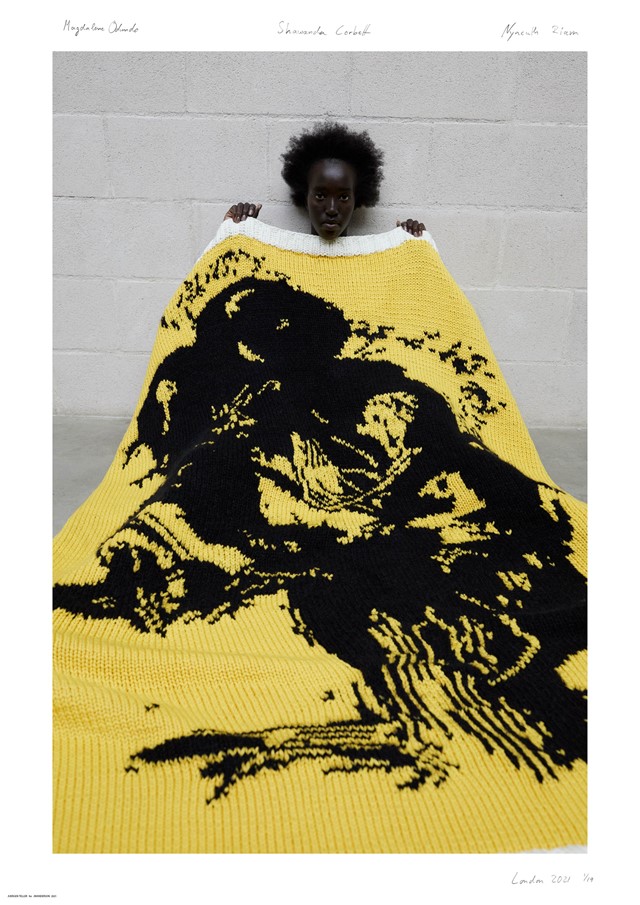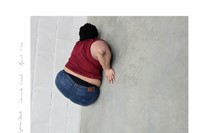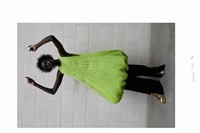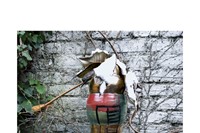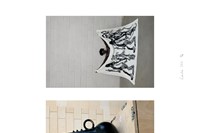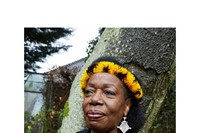As his Autumn/Winter 2021 collection launches, the designer reflects on a year of change and imagines what the future will hold for fashion
Earlier this month, Jonathan Anderson watched Adam Curtis’s new six-part documentary Can’t Get You Out Of My Head: An Emotional History of the Modern World – “it’s seven hours well spent,” the designer says over Zoom. Looking back over the past half century through collated archive footage, Curtis asks: how did we get to where we are now? And is there a way out? “It makes you question things,” says Anderson. “You look at history and think maybe we are making the same mistake over and over.”
This month’s shows come in a similar moment of contemplation about the future of fashion. After a year-or-so of uncertainty and clarion calls for change within the industry, we now approach a moment when things, in theory at least, could revert back to how they once were. It’s not what Anderson wants – “the idea of going back to what it was before is boring,” he says – but it is what he predicts. “I don’t think fashion was working [before the pandemic], I think we were at the end of a cycle, and the pandemic speeded that up. I think we will revert quickly back, and then it will crash.”
Which is why Anderson continues to set his own agenda: this season, he showed outside of the London Fashion Week schedule, delivering a roll of Juergen-Teller shot posters of the collection to editors’ front doors (his absence from the schedule was not entirely purposeful, he says – in lockdown, the printing simply wasn’t able to happen fast enough). Each poster is double-sided, featuring portraits of the artists Dame Magdalene Odundo and Shawanda Corbett, set against images of their respective work. Alongside, the model Nyaueth Riam wears the collection’s looks. “What kind of creative future do we want?” Anderson asks in a letter rolled up into the package.
It’s an evolution of his ‘show-in-a-box’ format he’s honed at both his eponymous label and at Loewe, where evermore intricate printed ephemera and objects are collated in lieu of a physical show. “In a weird way I am nervous going back to shows because I’ve really enjoyed this process, everytime we do something it’s a bit like ‘wow’,” Anderson says of the process. Via the boxes themselves, and the accompanying ‘unboxing’ films on the brand’s Instagram account – whereby the designer talks through the collection and its inspirations – Anderson believes he is finding a more democratic approach, a way of speaking directly to customers who before the pandemic he just wasn’t reaching.

“I think in a way it opens these doors into new dialogues and new propositions. I get messages from young people saying: ‘I’m so glad you talked about how you did the music for the show. I understand you more’,” he says. “I thought I talked a lot, but it was always filtered through the press. I think I will now always explain the collections that way, because it gets me to talk directly through the screen to the audience. That is something that I would have never learnt without the pandemic.”
The collection itself began with a look backwards to his 2017 interdisciplinary exhibition Disobedient Bodies at the Hepworth Wakefield, which saw the designer trace lines between art, fashion and the body. “I think there’s this idea of the silhouette, when you take a pen and draw something on the page – this working out of volume,” Anderson says. “That’s what ties everything: how do you reinterpret the body? Which goes back to the idea of [the exhibition]. I’ve always been obsessed by Barbara Hepworth, and then looking at what Christian Dior was doing in that exact same period. Or Eileen Gray and Madame Grès.”
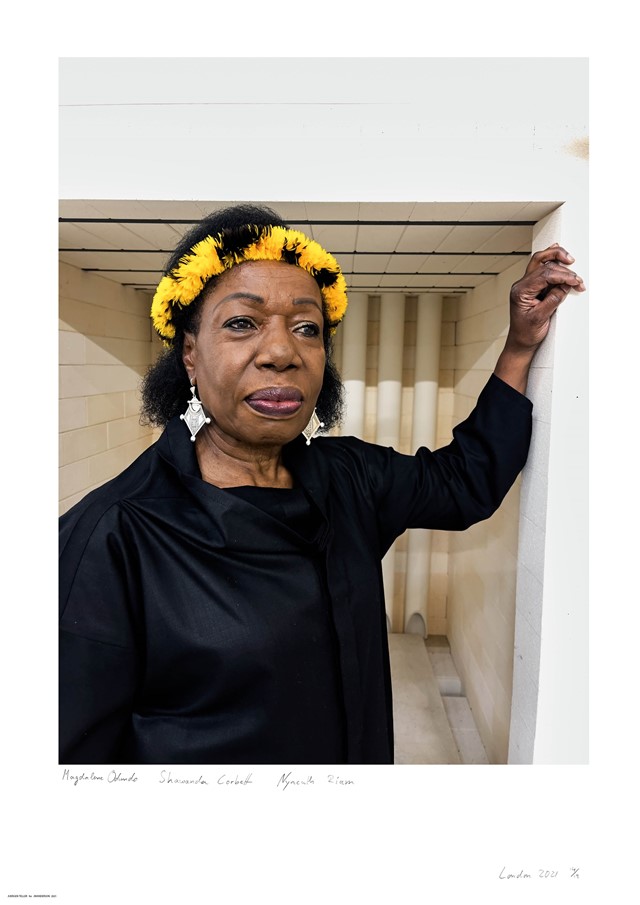
Odundo herself was part of the Hepworth exhibition and Anderson, who regularly visits her studio, calls her “probably the most important ceramicist of the 21st century” and a close friend. “Being able to sit at a kitchen table and engage in a creative conversation with someone whom I respect so much was invigorating; it sparked ideas,” he writes in the collection’s accompanying letter. In the latter half of last year he encountered US-born Corbett’s work at London’s Corvi-Mora Gallery – a brief moment in time where galleries reopened last year – and was struck by her totemic ceramic vessels, inspired by the human form. Speaking to Odundo, he found that she too admired Corbett’s work – and vice-versa, as they would later discover – and a conversation between the two artists and Anderson began, culminating in the Teller-shot images and a series of six limited-edition blankets featuring their work.
“I thought it was a really interesting generational dialogue, so that kind of brought me back to the Hepworth,” he says. “I don’t have a building to show things in, but I thought well why don’t we do a collaboration, and show it in the context of picking up these dialogues.”
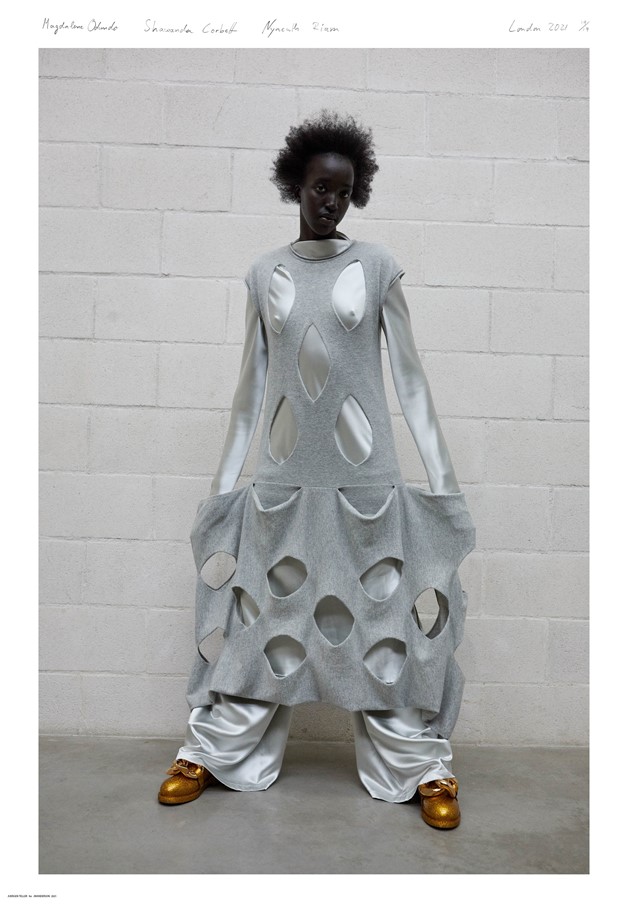
Odundo and Corbett’s vessel-like forms find reflection in Anderson’s clothing: a ballooning silhouette recurs throughout, where dresses are expansive and voluptuous (the knit dresses were expanded with interior netted tubing which took months to perfect). Cocooning, cape-like outerwear has a similarly sculptural impact. A white jumpsuit is elongated at the sleeves, worn with a giant pom-pom bag; wide-leg trousers split towards the ankle, their fabric pooling on the floor. “Experimental volumes,” Anderson described.
It all in some way returns to Disobedient Bodies, to the idea of looking back to move forward. “Creatively, I think we’re all searching in different ways to represent the body ultimately,” he says. “In hindsight I realised just how much effect that show had on my creative viewpoint. I think the reason I went back to that moment was because I was never done with it.”
